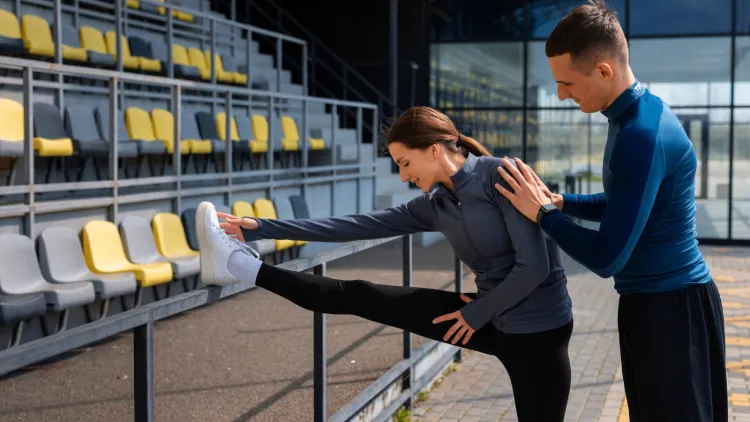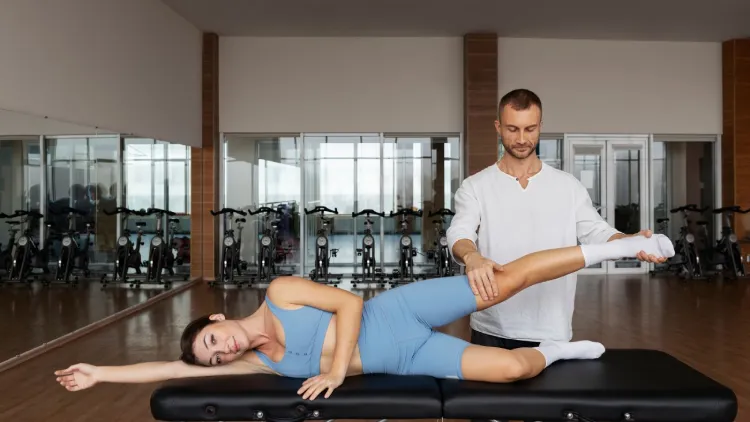Hyperextensions work the lower back, glutes and hamstrings, but it does not require a bench to perform. Hyperextension alternatives that allow greater amounts of flexion during exercises such as RDLs, good mornings, glute bridges, supermans, and bird dogs can achieve the same benefit with the additional benefits of improved posture, core stability, and glute growth, all without the risk of overextension that hyperextension exercises pose.
- Why Look for a Hyperextension Alternative?
- Are Hyperextensions the Same as Back Extensions?
- Muscles Targeted in Hyperextensions
- Best Hyperextension Alternatives
- Safety, Risks, and Myths About Hyperextensions
- Hyperextension vs Reverse Hyper vs Deadlift
- Other Related Movements
- How to Do Hyperextensions at Home (Without a Machine)
- Final Thoughts
- Frequently Asked Questions
Why Look for a Hyperextension Alternative?
Hyperextensions, also known as back extensions, are also a staple of strength-training programs. The muscles they emphasise include the spinal erectors, glutes and hamstring muscles via a controlled hip hinge movement. But there are some reasons why people would seek a hyperextension alternative:
- No Equipment: A Hyperextension bench or roman chair is often not available in your home or small gym.
- Back: Back pain is a point of concern to some people due to improper form or hyperextension that is too far.
- Variety in Exercise: Repetition of a particular movement over time would lead to plateaus. Different exercises make exercises efficient.
- Low Risk Alternatives: Some variations put less strain on the spine and yet exercise the same muscle groups.
It is important to mention that hyperextensions are not necessarily harmful, but their inappropriate performance, including arching too much at the top and jerking motions, can cause strain. That is why hyperextension alternatives are discussed by many health-conscious people who seek safer, yet equally effective variants to perform.

Are Hyperextensions the Same as Back Extensions?
The two terms hyperextension and back extension are usually used interchangeably. A back extension is technically an extension of the torso until it is parallel to the legs, whereas a hyperextension is beyond the normal adjustment of the two. This slight distinction is important, since overly hyperextended positions inadvertently strain the spine. To be safe, most trainers advise resting in the neutral position; in other words, the movement is basically a back extension under control.
Muscles Targeted in Hyperextensions
The hyperextension does the core benefit mainly by strengthening the erector spinae muscles of the lower back, but also the other muscles:
- Glutes – these are concerned with the extension of the hips and hip stability.
- Hamstrings – come into action during the hinging motion
- Core muscles – recruited to help stabilise the spine.
Due to this, hyperextensions (and alternative exercises) can be found in posterior chain routines. It is also practical in correcting the posture since well-taught erectors in the spine are useful in stopping slouching.

Best Hyperextension Alternatives
Regarding the substitution of hyperextensions, the aim is to get the same anatomical movement pattern and also exercise the same muscle group. These are the most viable possibilities:
1. Good Mornings
Good mornings are the nearest substitutes to hyperextensions. They may use a barbell, a dumbbell, or a resistance band.
- How to do it: Stand straight with the barbell on your shoulders. With your back flat, hinge at your hips until your torso is just about parallel with the floor, and pull yourself back up.
- The Benefits: Strength in the hamstrings and the glutes is likely to be developed, and hinge movements are reified with proper movement.
- Safety Tip: To begin, have lightweight so that you do not strain your lower back.
2. Romanian Deadlifts
Romanian deadlifts are an excellent hyperextension alternative since they not only engage the spinal erectors, but also the hamstrings and glutes at the same time.
- The way to do it: Stand with weights on the level of your hips. Bend at the hips with the slight bend of the knees, bringing the weight down to the mid-shin position. When you straighten up, push your hips forward.
- Why it is great: By comparison to conventional deadlifts, which train the concentric (upward) contraction more effectively, RDLs focus more on the eccentric (downward) phase and, therefore, are effective in hamstring training.
- Comparison: Deadlifts are most often used to gain total body strength, but RDLs are much more specific to hyperextensions.
3. Supermans
In case you require an alternative to hyperextensions that uses only bodyweight, supermans are another potentially effective exercise.
- How it is done: Lie down prone on the floor. Spread your arms in front and your legs behind. Raise the arms and legs at the same time, and hold, lower them.
- Pros: Workouts the erector spinae muscles without requiring equipment, thus coupling it with a home workout.
- Variation: Insert a pause or use light dumbbells to make it more difficult.
4. Bird Dogs
Bird dogs are both a safer option and also build stability and coordination.
- How to: Start on all fours. Stretch your right arm in front of you and your left leg behind you, with your back straight. And reverse.
- Benefits: This exercise stimulates all the important muscles (the core, glutes and back muscles) and reduces the compression of the spine.
- Why it matters: This is a great exercise to do when you tend to experience lower back pain and will help stabilise the back.
5. Glutes Bridges and Hip Thrusts
An alternative that works well as a hyperextension and focuses more on the glutes is glute bridges and hip thrusts.
- How to do it (Glute Bridge): Lie down with knees upward, your feet flat. Push your feet through your heels to lift your hips, strengthening the glutes at the end position.
- Hip Thrust (How to do it): Hip Thrust is carried out in an identical motion, but with the shoulders resting on a bench, using added resistance (barbell or band).
- The reason it works: These motions are most effective at activating glutes- the most of any lower-body exercise and strengthen the hamstrings as well.
6. Kettlebell Swings
A more energetic option, a kettlebell swing, is a cardiopulmonary exercise coupled with posterior chain development.
- How to do it: Kettlebell in both hands. Hinge at the hips and swing it between your knees, then push your hips into it to swing the club chest high.
- Advantages: Increases explosive hip strength, endurance and grip strength.
- Note: Hip drive is important- do not pull with the arms.
7. Hypers with or without Machine Backwards (Reversed)
One of the most common close substitutes of traditional hyperextensions is the reverse hyper, especially when training the glutes. In the event that you have no reverse hyper machine, then a bench can work.
- How to do it: Lie down with your face on a bench with your hips on the edge. Put your legs down straight. On raising the weight, raise it defly up to parallel, and then lower it slowly.
- Why it is so awesome: It targets the glutes-hamstrings in isolation and decreases compression load on the lower back.
- Bonus: Reverse hypers can be a favourite among athletes who would like to grow their glutes and open up their spine during the process.

Safety, Risks, and Myths About Hyperextensions
Hyperextensions are avoided by some because they fear being hurt. Although not necessarily harmful, issues emerge when the back has a tendency to over-arch (true hyperextension) or when excess load is introduced too prematurely.
- Common query: Are hyperextensions bad for the back?” → No, when done with correct form and control.
- Disadvantage: Back pain could be a result of overuse or wrong form.
- Long-lasting risks: Straining beyond the limit by repeated hyperextension might stretch the discs of the spine.
Pro Tip: Perform this lightly and pause at a position of neutral spine without bouncing at the bottom.
Hyperextension vs Reverse Hyper vs Deadlift
- Hyperextension vs Reverse Hyper: Reverse hypers make use of more glutes and can be considered safer on the lower back. Hip Hyperextensions will mainly target the glutes and erector spinae muscles, but may bring injury when performed in an improper manner.
- Hyperextension vs Deadlift: Both exercises tend to develop more strength and muscle mass, but hyperextension is more suitable for developing endurance and isolating specific muscles.
- Which one is superior? → Deadlifts are superior as far as overall strength is concerned. Reverse hypers are awesome for growing the glutes. Hyperextensions are effective at developing spinal erector endurance- provided they are done right.
Other Related Movements
- Sumo Squats: A variant on squats prepared in a wide stance and having toes out, more emphasis is put on the inner thigh muscles and glutes.
- The opposite of Hyperextension: Flexion (bending forward and not extending backwards).
- Glute Shelf Development: Exercises such as hip thrusts and glute bridges, and reverse hypers work best to develop the upper glute.

How to Do Hyperextensions at Home (Without a Machine)
In case you do not have a hyperextension bench available, you can make do:
- On the floor: supermans or bird dogs.
- On a couch or bench: Climb on top, face down on the edge of the hips and dangle the legs. Lift your legs as a reverse hyper.
- Resistance: There can be an added challenge by using a stability ball against a wall.
These techniques can help you perform back extensions in a safe and effective manner with or without having exercise apparatus.

Final Thoughts
Hyperextensions are effective when it comes to the training of the posterior chain; however, they are not the only exercise. With so many hyperextension alternatives, you have several options: to avoid lower back discomfort, lack of a bench, or just a desire to work on multiple variations, you can utilise Romanian deadlifts, good mornings, superman, bird dog, and glute bridges. Each has its own proprietary benefits–including posture and stability enhancement, as well as optimising glute activation.
The trick is to emphasise form, not exaggerate arching, and go with the variation that best suits your intentions. Hip thrusts and reverse hypers are great for growing glutes. RDLs and kettlebell swings are best at full posterior chain strength. To work without equipment, there are supermans and bird dogs.
Swapping out these hyperextension alternatives into your regimen will develop a strong, balanced back and glutes without going into hyperextension—and without relying on a single exercise.
Frequently Asked Questions
1. What are alternative good exercises to replace hyperextensions?
You can substitute hyperextension with Romanian deadlifts, good mornings, supermans, glute bridges, bird dogs and kettlebell swings. These are lower back and glutes with hamstrings strengthening activities that do not involve a hyperextension bench.
2. Are Hyperextensions bad for your back?
Hyperextensions, when done incorrectly, may cause damage to the spine; however, in and of itself, this exercise is not harmful. Alternatives such as reverse hypers, bird dogs or bridges to the buttocks are usually suggested to protect against back pain.
3. Do gluteal hyperextension alternatives still build glutes?
Yes. Exercises such as reverse hyper, hip thrust and glute bridge perform remarkably well in terms of glute activation and can even lead to greater muscle gain in that part as compared to conventional hyperextensions.
4. What is a good way to do back extensions without a machine?
You can get the same effect if you do supermans on the floor, or bird dogs in a tabletop position. You can also use reverse hypers by moving into a face-down position on a bench or a couch with your feet hanging off the end.







